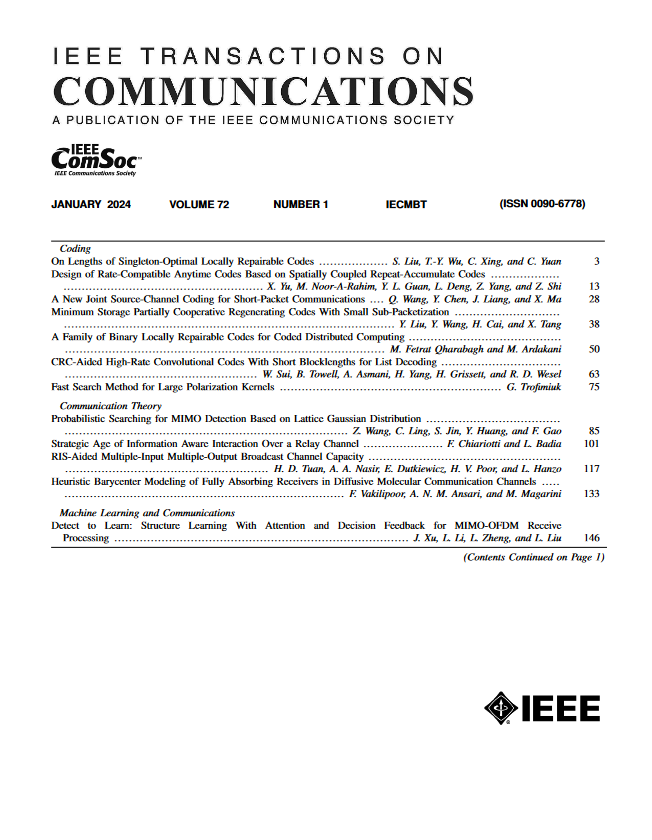Physics-Regulated Digital Backpropagation for Optical Fiber Systems With Imprecise Parameters
IF 8.3
2区 计算机科学
Q1 ENGINEERING, ELECTRICAL & ELECTRONIC
引用次数: 0
Abstract
Current signal processing algorithms excel at impairment compensation when the parameters of optical fiber systems are precisely defined. However, their effectiveness diminishes considerably in the presence of imprecise parameters. By integrating ‘knowledge application from physics to neural networks (NN)’ with ‘information feedback from NNs to physics’, this paper proposes a physics-regulated digital backpropagation (PR-DBP) algorithm, which shows great promise for impairment compensation with imprecise fiber parameters. The PR-DBP employs an optimization-estimation-initialization loop structure. The optimization process provides the network’s adaptability by minimizing the loss value as in conventional NNs. The estimation process dynamically tracks physical parameters by extracting information from NNs to the physical domain. The initialization process offers a physics-based global control over the neural network, thereby mitigating the risk of overfitting by preventing an excessive focus on loss minimization. Moreover, a phase-shift weight function is applied to further improve algorithmic efficiency. Numerical analyses indicate that the PR-DBP significantly outperforms conventional methods in optical fiber systems with imprecise parameters, achieving a bit error rate reduction by an order of magnitude. As a mutually reinforcing part of impairment compensation, a high-accuracy and adaptive fiber parameter estimation is also demonstrated.不精确参数光纤系统的物理调节数字反向传播
当前的信号处理算法在精确定义光纤系统参数的情况下,擅长于损伤补偿。然而,在存在不精确的参数时,它们的有效性大大降低。通过将“从物理到神经网络的知识应用”与“从神经网络到物理的信息反馈”相结合,本文提出了一种物理调节的数字反向传播(PR-DBP)算法,该算法在不精确光纤参数的损伤补偿方面表现出很大的希望。PR-DBP采用优化-估计-初始化循环结构。与传统神经网络一样,优化过程通过最小化损失值来提供网络的适应性。估计过程通过从神经网络中提取信息到物理域来动态跟踪物理参数。初始化过程提供了对神经网络的基于物理的全局控制,从而通过防止过度关注损失最小化来降低过拟合的风险。此外,为了进一步提高算法效率,还引入了相移权函数。数值分析表明,在参数不精确的光纤系统中,PR-DBP显著优于传统方法,误码率降低了一个数量级。作为损伤补偿的一个相辅相成的部分,本文还演示了一种高精度、自适应的光纤参数估计方法。
本文章由计算机程序翻译,如有差异,请以英文原文为准。
求助全文
约1分钟内获得全文
求助全文
来源期刊

IEEE Transactions on Communications
工程技术-电信学
CiteScore
16.10
自引率
8.40%
发文量
528
审稿时长
4.1 months
期刊介绍:
The IEEE Transactions on Communications is dedicated to publishing high-quality manuscripts that showcase advancements in the state-of-the-art of telecommunications. Our scope encompasses all aspects of telecommunications, including telephone, telegraphy, facsimile, and television, facilitated by electromagnetic propagation methods such as radio, wire, aerial, underground, coaxial, and submarine cables, as well as waveguides, communication satellites, and lasers. We cover telecommunications in various settings, including marine, aeronautical, space, and fixed station services, addressing topics such as repeaters, radio relaying, signal storage, regeneration, error detection and correction, multiplexing, carrier techniques, communication switching systems, data communications, and communication theory. Join us in advancing the field of telecommunications through groundbreaking research and innovation.
 求助内容:
求助内容: 应助结果提醒方式:
应助结果提醒方式:


